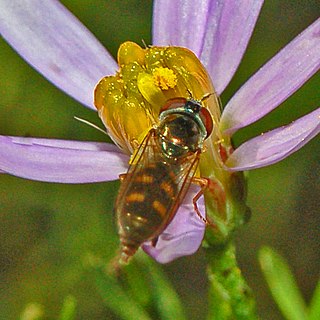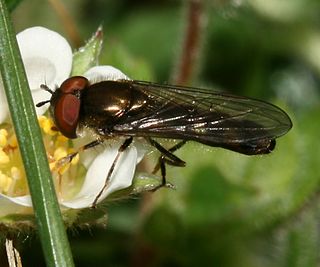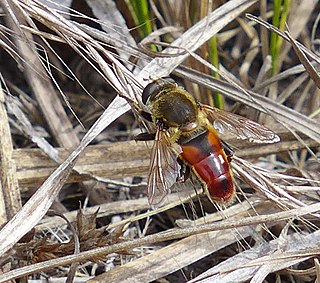
Platycheirus clypeatus is a species of hoverfly. It is found across the Palearctic and in the Nearctic. The larvae feed on aphids. Adults are usually found on the edges of woodland or scrub, heath or along hedgerows where they visit a wide range of flowers.

Platycheirus is a large genus of hoverflies. They are also called sedgesitters.

Platycheirus scambus is a species of hoverfly. It is a Holarctic species.

Platycheirus scutatus is a very common species of hoverfly. It is a Holarctic species.

Melanostoma mellinum is a very common species of hoverfly found in many parts of Britain, Europe including the Mediterranean basin and North Africa, the East Palearctic, and North America.

Platycheirus albimanus is a common widespread species of hoverfly. A holarctic species its range includes Greenland, Iceland, Britain, mainland Europe, Russia, across Siberia to the pacific coast, the Philippines, Alaska, western Canada and United States.

Lejops is a genus of hoverflies, closely related to the genera Helophilus, Quichuana and Mallota.

Platycheirus ambiguus is a small widespread species of hoverfly found across the Palearctic from Ireland to Japan. A spring species found in flight in April and May, it visits spring-flowering trees and shrubs, e.g., Prunus spinosa in deciduous woodland and scrub.

Platycheirus angustatus is a species of hoverfly. It is found in many parts of the Palearctic, and in the Nearctic.

Platycheirus discimanus, the Yellowfoot Sedgesitter is a small species of hoverfly. It is found across Europe and the Palearctic and in North America.
Platycheirus perpallidus is a species of hoverfly. It is a Holarctic species.
Platycheirus podagratus is a species of hoverfly. It is found in the Holarctic.
Platycheirus hyperboreus is a species of syrphid fly in the family Syrphidae. In N America hyperboreus is broadly distributed across Alaska, Canada, Greenland and the northern United States, ranging as far south as North Carolina in the east and Nevada. In western and northern Europe ranging from Norway, Finland, northern Russia and on into northern Siberia.

Polydontomyia is a genus of rat-tail maggot flies in the family Syrphidae. The genus is monotypic, comprising a single species, Polydontomyia curvipes, also known as the dimorphic sickleleg. It was formerly a member of the genus Lejops.
Platycheirus inversus, also known as the knobfoot sedgesitter, is a rare species of syrphid fly observed in Northeastern North America. Hoverflies can remain nearly motionless in flight. The adults are also known as flower flies for they are commonly found on flowers, from which they get both energy-giving nectar and protein-rich pollen. Larvae are aphid predators.
Platycheirus normae, the paddlearm sedgesitter, is a rare species of syrphid fly observed in northeastern North America. Hoverflies can remain nearly motionless in flight. The adults are also known as flower flies for they are commonly found on flowers, from which they get both energy-giving nectar and protein-rich pollen. Larvae are aphid predators.
Platycheirus scamboides, the yellowspine sedgesitter, is a rare species of syrphid fly observed in northeastern North America. Hoverflies can remain nearly motionless in flight. The adults are also known as flower flies for they are commonly found on flowers, from which they get both energy-giving nectar and protein-rich pollen. Larvae are aphid predators.
Platycheirus varipes is a rare species of syrphid fly observed in Northern Europe: Norway, Sweden, Finland; Greenland; central Asiatic Russia; and in North America from Alaska and Canada south to Colorado, via mountain chains.









